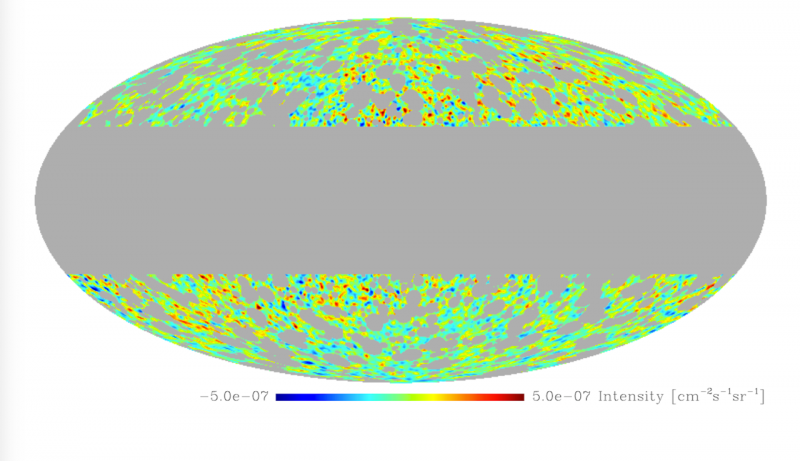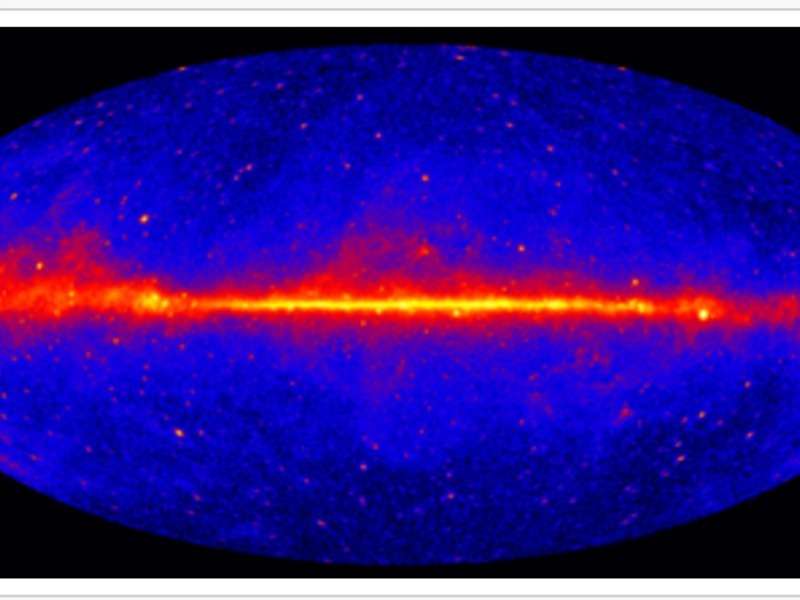No trace of dark matter in gamma-ray background

Researchers from the University of Amsterdam's (UvA) GRAPPA Center of Excellence have just published the most precise analysis of the fluctuations in the gamma-ray background to date. By making use of more than six years of data gathered by the Fermi Large Area Telescope, the researchers found two different source classes contributing to the gamma-ray background. No traces of a contribution of dark matter particles were found in the analysis. The collaborative study was performed by an international group of researchers and is published in the latest edition of the journal Physical Review D.
Gamma rays are particles of light, or photons, with the highest energy in the universe and are invisible to the human eye. The most common emitters of gamma rays are blazars: supermassive black holes at the centers of galaxies. In smaller numbers, gammy rays are also produced by a certain kind of stars called pulsars and in huge stellar explosions such as supernovae.
In 2008 NASA launched the Fermi satellite to map the gamma-ray universe with extreme accuracy. The Large Area Telescope, mounted on the Fermi satellite, has been taking data ever since. It continuously scans the entire sky every three hours. The majority of the detected gamma rays is produced in our own Galaxy (the Milky Way), but the Fermi telescope also managed to detect more than 3000 extragalactic sources (according to the latest count performed in January 2016). However, these individual sources are not enough to explain the total amount of gamma-ray photons coming from outside our Galaxy. In fact, about 75% of them are unaccounted for.
Isotropic gamma-ray background
As far back as the late 1960s, orbiting observatories found a diffuse background of gamma rays streaming from all directions in the universe. If you had gamma-ray vision, and looked at the sky, there would be no place that would be dark.
The source of this so-called isotropic gamma-ray background has hitherto remained unknown. This radiation could be produced by unresolved blazars, or other sources too faint to be detected with the Fermi telescope. Parts of the gamma-ray background might also hold the fingerprint of the illustrious dark matter particle, a so-far undetected particle held responsible for the missing 80% of the matter in our universe. If two dark matter particles collide, they can annihilate and produce a signature of gamma-ray photons.

Fluctuations
Together with colleagues, Dr Mattia Fornasa, an astroparticle physicist at the UvA and lead author of the paper, performed an extensive analysis of the gamma-ray background by using 81 months of data gathered by the Fermi Large Area Telescope – much more data and with a larger energy range than in previous studies. By studying the fluctuations in the intensity of the gamma-ray background, the researchers were able to distinguish two different contributions to the gamma-ray background. One class of gamma-ray sources is needed to explain the fluctuations at low energies (below 1 GeV) and another type to generate the fluctuations at higher energy – the signatures of these two contributions is markedly different.
In their paper the researchers suggest that the gamma rays in the high-energy ranges – from a few GeV up – are likely originating from unresolved blazars. Further investigation into these potential sources is currently being carried out by Fornasa, fellow UvA researcher Shin'ichiro Ando and colleagues from the University of Torino, Italy. However, it seems much harder to pinpoint a source for the fluctuations with energies below 1 GeV. None of the known gamma-ray emitters have a behaviour that is consistent with the new data.
Constraints on dark matter
To date, the Fermi telescope has not detected any conclusive indication of gamma-ray emission originating from dark-matter particles. Also, this latest study showed no indication of a signal associated with dark matter. Using their data, Fornasa and colleagues were even able to rule out some models of dark matter that would have produced a detectable signal.
'Our measurement complements other search campaigns that used gamma rays to look for dark matter and it confirms that there is little room left for dark matter induced gamma-ray emission in the isotropic gamma-ray background,' says Fornasa.
More information: 'The Angular Power Spectrum of the Diffuse Gamma-ray Emission as Measured by the Fermi Large Area Telescope and Constraints on its Dark Matter Interpretation' in Physical Review D. D 94, 123005, 9 December 2016. dx.doi.org/10.1103/PhysRevD.85.083007
Journal information: Physical Review D
Provided by University of Amsterdam




















